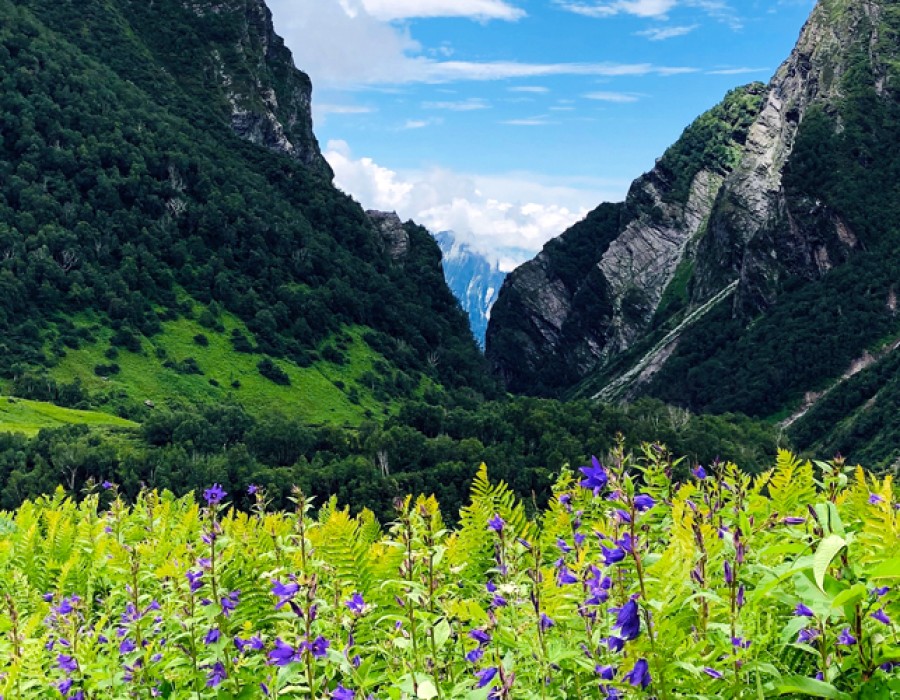Intresting Facts about Valley of Flower trek
Unesco World Heritage Site: The Valley of Flowers was inscribed as a UNESCO World Heritage Site in 2005 due to its extraordinary natural beauty and significant biodiversity. This recognition underscores its global importance as a site for conservation and preservation. The valley represents a unique ecosystem with a diverse range of flora and fauna, making it a vital area for scientific research and ecological understanding. Its inclusion on the UNESCO list helps raise awareness about the need to protect such fragile environments and promotes sustainable tourism practices.
Hidden Gem: Before mountaineer Frank Smythe stumbled upon it in 1931, the Valley of Flowers trek remained a hidden gem, unknown to the wider world. Smythe's accidental discovery brought attention to this pristine Himalayan valley, captivating the imagination of explorers and nature enthusiasts alike. Its secluded location, nestled within the rugged terrain of Uttarakhand, adds to its mystique. Despite its hidden status, the valley's allure is now widely recognized, drawing visitors from around the globe to witness its natural splendor.
Rare Flora: The Valley of Flowers boasts an astonishing diversity of flora, with over 500 species of wildflowers, including many rare and endangered ones. Among these botanical treasures are the Brahma Kamal, Blue Poppy, and Cobra Lily, which thrive in the valley's unique microclimate. The presence of such rare and delicate flowers makes the valley a botanical paradise and a hotspot for plant enthusiasts and researchers. Efforts to conserve these species are crucial to maintaining the valley's ecological balance and preserving its floral heritage.
Seasonal Bloom: The Valley of Flowers undergoes a remarkable transformation during the monsoon season, typically from July to September, when the flowers burst into full bloom. This seasonal spectacle paints the landscape with vibrant colors, creating a breathtaking mosaic of hues. The timing of the bloom is synchronized with the monsoon rains, which provide the necessary moisture for the flowers to thrive. The fleeting beauty of the bloom adds to the valley's allure, attracting visitors who wish to witness nature's ephemeral masterpiece.
Himalayan Wildlife: In addition to its diverse flora, the Valley of Flowers is home to a variety of wildlife species, adapted to the harsh conditions of the Himalayan region. Among the inhabitants are the elusive snow leopard, Himalayan black bear, musk deer, and a plethora of bird species. These animals play integral roles in the valley's ecosystem, contributing to its ecological balance. Conservation efforts aim to protect both the flora and fauna of the valley, ensuring their survival for future generations to appreciate.
Historical Connection: According to Hindu mythology, the Valley of Flowers holds a special place in the epic tale of the Ramayana. Legend has it that Hanuman, the monkey god, visited the valley in search of the mythical Sanjeevani herb to save Lakshmana, who was injured in battle. The valley's association with this ancient legend adds to its cultural significance, attracting pilgrims and devotees who seek to explore its mythological roots.
Altitude: Situated at an altitude ranging from 3,500 to 4,000 meters above sea level, the Valley of Flowers presents a challenging yet rewarding trekking destination. The high altitude offers breathtaking views of the surrounding Himalayan peaks and valleys, rewarding trekkers with unparalleled vistas. However, the thin air and rugged terrain pose physical challenges, requiring proper acclimatization and fitness preparation. Despite the difficulties, the journey to the valley's lofty heights is an adventure worth undertaking for those seeking an unforgettable experience in the mountains.
Conservation Efforts: Recognizing the ecological importance of the Valley of Flowers, the Indian government declared it a national park in 1982. This designation aims to protect and preserve its unique biodiversity and fragile ecosystem. Conservation efforts include habitat restoration, wildlife monitoring, and sustainable tourism practices. Strict regulations govern visitors' activities to minimize their impact on the environment, ensuring that the valley remains a sanctuary for generations to come.
Accessibility: The trek to the Valley of Flowers typically begins from Govindghat in Uttarakhand, serving as the gateway to this natural wonder. The trek route passes through diverse landscapes, including forests, meadows, and river valleys, offering trekkers a varied and scenic journey. Depending on the chosen route and pace, the trek usually takes 4-6 days to complete, providing ample opportunities to immerse oneself in the beauty of the surroundings and connect with nature.
Stunning Landscapes: Beyond its floral beauty, the Valley of Flowers captivates trekkers with its stunning landscapes, including panoramic views of snow-capped peaks, glaciers, and cascading waterfalls. Each turn of the trail reveals a new vista, showcasing the grandeur of the Himalayas in all its glory. The diversity of landscapes encountered along the trek adds to the richness of the experience, inspiring awe and appreciation for the natural world.
Ethnic Diversity: The villages surrounding the Valley of Flowers are inhabited by diverse ethnic groups, each with its own cultural heritage and traditions. Among them are the Bhotias, who have long-standing ties to the mountains and the land. Their way of life reflects a deep respect for nature and a harmonious relationship with the environment. Interactions with local communities enrich the trekking experience, providing insights into the region's cultural diversity and history.
Medicinal Plants: Many of the flowers found in the Valley of Flowers possess medicinal properties and are valued in traditional Ayurvedic medicine. The Brahma Kamal, for example, is believed to have healing properties and is used to treat various ailments. The valley's rich botanical diversity offers potential benefits for human health beyond its aesthetic appeal, underscoring the importance of preserving these natural resources for future generations.
Book Package now: Book your package now for valley of Flower trek from Delhi to Rishikesh with Go4Explore and got chance to travel the world with us.





Comments